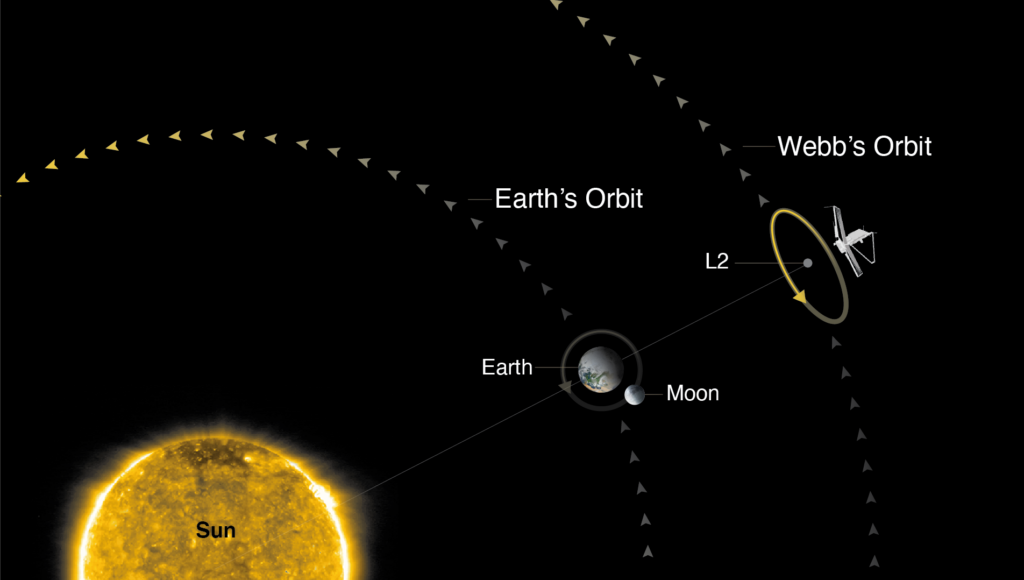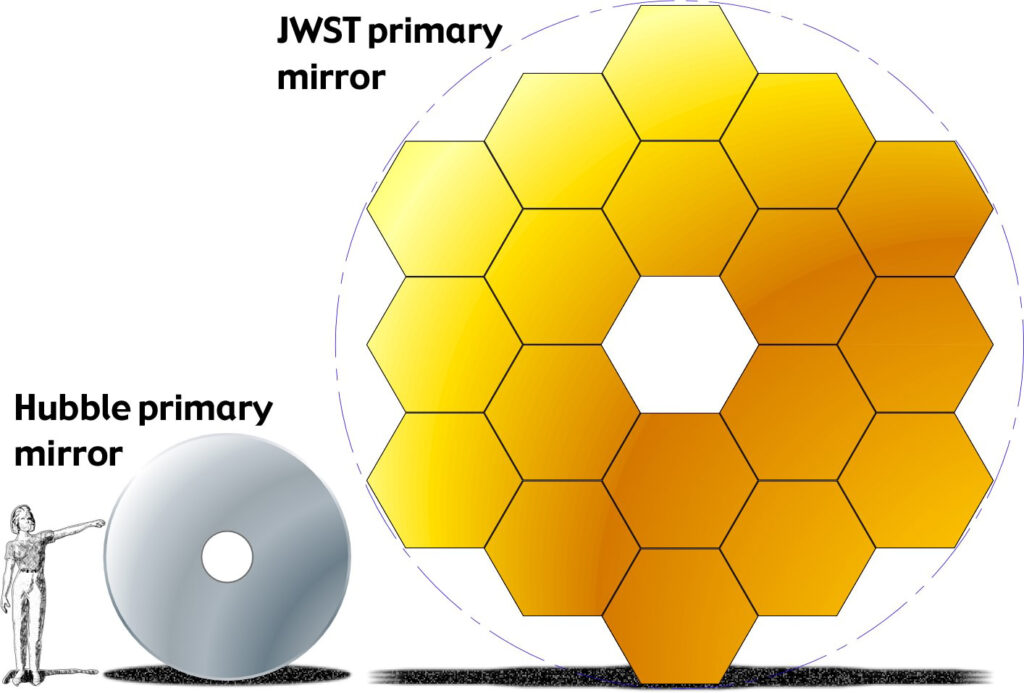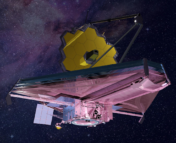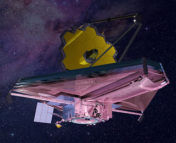NASA’s “Great Observatories”—a series of revolutionary space telescopes launched in the 1990s to early 2000s, including the Hubble Space Telescope—showed us so many new facets of our universe. Now, the long-awaited era of the New Great Observatories is beginning, starting with the upcoming launch of JWST in just about a week.
On the morning of December 24th, 2021, JWST is planned to launch from French Guiana aboard one of the European Space Agency’s Ariane 5 rockets. (Subject to delays…which we’ll get into in a moment!) In today’s Bite, we’ll review the history, design, and (hopefully!) very bright future of this highly anticipated space telescope.

Even before the launch of the Hubble Space Telescope in the 1990s, plans for the next great observatory had begun, with astronomers imagining a large, near-infrared space telescope known as the Next Generation Space Telescope. Construction began on the project in the early 2000s, when it was also officially re-named the James Webb Space Telescope (JWST). It’s worth noting that there has been substantial pushback from the astronomical community against this name choice, so we will simply refer to the telescope as JWST. Over the course of two decades, the telescope was assembled and rigorously tested to ensure it performs as expected when it reaches its destination a million miles from Earth.
About the Mission
Unlike Hubble orbiting Earth, JWST is headed far away from our planet, beyond the reach of where astronauts can help fix it. The telescope will eventually orbit near L2, a region of gravitational balance between the Earth and the Sun known as a Lagrange point. It has to be further from the bright light of the Sun, Moon, and Earth to keep it cool, since it’s going to be observing in infrared light. The telescope is also equipped with a sunshield the size of a tennis court to further protect it from sunlight and keep things cold!
The planned mission is 5 years, but there’s enough fuel onboard for JWST to maintain its L2 orbit for 10 years. Although it seems a bit scary that the telescope will be too far away to be serviced, it’s not the first telescope to be in an unserviceable orbit—Spitzer and Herschel both had successful missions far from Earth!

Due to its large size, JWST’s mirrors and sunshield will unfold over the course of its first few months in space, on its way to L2. Its famous honeycombed primary mirror consists of 18 hexagonal segments, made with lightweight beryllium and all coated in a thin layer of gold to improve how they reflect infrared light. At 6.5 meters in diameter—about the height of a big giraffe—JWST’s mirror is huge. For comparison, Hubble’s mirror is only 2.4 meters across. One of the fundamental principles of astronomy is the bigger the bucket you have to collect light, the better images you can get—and JWST is our biggest light bucket in space yet! Years of innovation and testing were required to make this mirror design possible.

Now, JWST is packed up on a rocket and getting ready for launch. The project has had many delays over the years—so many, in fact, that we have Astrobites from 2017 talking about a launch date in 2018 and original telescope plans from the 1990s projected a launch date of 2007. A recent delay pushed the launch date from December 22nd to December 24th, but the most recent updates at the time of this writing state the team is on track to launch Christmas Day at 7:20am ET. After almost a decade, the time has finally come, so let’s talk about what JWST will be able to do for astronomy!
JWST’s Instruments
JWST is designed to observe in the near- and mid-infrared. Infrared allows us to look through the dust in the universe, like the Spitzer Space Telescope did, but with JWST’s larger mirror it’ll have incredible resolution.
The telescope is equipped with four main instruments: the Near Infrared Camera (NIRCam), the Near Infrared Spectrograph (NIRSpec), the Mid-Infrared Instrument (MIRI), and the Fine Guidance Sensor / Near Infrared Imager and Slitless Spectrograph (FGS/NIRISS). NIRCam is JWST’s main imaging instrument, observing in the infrared from 0.6 to 5 microns, and contains a coronagraph to detect faint objects, like planets. NIRSpec is also looking from 0.6 to 5 microns, but it has a different job. It’s a spectrograph, meant to obtain spectra of objects to determine their compositions and more. It can obtain up to 100 spectra simultaneously thanks to a new technology called a “microshutter array” that allows astronomers to strategically block out portions of the sky to focus on the objects they want.
MIRI is looking further into the infrared, from 5 to 28 microns, with both an imaging camera and a spectrograph. In order to observe at these long wavelengths, MIRI is actively cooled using a “cryocooler” that keeps its temperature to less than 7 Kelvin (that’s less than -450 degrees Fahrenheit!). The FGS half of FGS/NIRISS helps JWST point correctly at its targets, and NIRISS provides other specialized observing capabilities to complement NIRCam and NIRSpec in the 0.6 to 5 micron range.
Some Exciting Science to Come!
All these instruments are designed to serve the mission’s science goals. JWST has four main science themes: looking into the early universe, observing galaxies over time, seeing through dust to understand the lifecycle of stars, and characterizing other worlds.
With its powerful infrared capabilities, JWST will be able to look far back into the universe. Since the universe is expanding, light from distant objects is stretched out (redshifted) so the most distant objects in the universe need to be observed in the infrared. One of the main eras of interest is reionization, when the first stars and galaxies lit up the universe. JWST is poised to answer questions like “how did reionization happen? What caused it? What do the first galaxies look like?” Observing these distant, early galaxies also allows astronomers to put together a more complete picture of how galaxies, and the black holes at their centers, have changed and evolved over time.
On a smaller scale, JWST will look through the dust surrounding forming stars and planets to better understand those processes. Although we have the basic idea of how stars form pretty much solidified, there are still many outstanding questions: Why do so many stars form in groups? How do stars spread heavy elements through the galaxy when they die? What are the details of how planets form?
JWST will also be searching for and characterizing exoplanets using two methods: transits and direct imaging. It’ll even be able to do transit spectroscopy to observe exoplanetary atmospheres, and will make observations of planets, asteroids, comets and more in our own solar system.
A whole host of science programs have already been approved and will be the first observations made with JWST. The details of all these exciting science cases can be found on Space Telescope Science Institute’s website.
The launch is only the beginning of JWST’s journey—it will experience “29 days on the edge” as it deploys over 50 moving parts, unfolding its origami-like sunshield and mirrors. Astronomers are certainly anxious, waiting for launch and intently following the updates on the mission, but the telescope has been rigorously tested for all steps of the process. All this unfolding will happen on the journey to its destination at L2, which should take about a month. Hopefully though, by next summer, JWST will be returning its first scientific images and data. There’s certainly a lot to look forward to!
Watch the launch broadcast live on December 25th starting at 6:30 am ET (actual launch 7:20 am ET) here on NASA’s YouTube! (Note: Launch date is accurate as of this bite’s update on December 21st, 2021. Check NASA’s Webb Updates Blog for the most up-to-date information.)
Want to learn more about JWST with Astrobites? Check out these other Bites related to the telescope and its science:
- Detecting non-uniform clouds on hot Jupiters in the era of JWST
- How NASA chooses its missions (and how you can help)
- Hydrate or Die-drate: Was Venus Ever Habitable?
- Earth’s Seven Cousins (TRAPPIST-1)
- How was the universe reionized? Cosmic sunbursts provide hints
- Searching for signs of life with the James Webb Space Telescope
- Crash course in exoplanet observations with the James Webb Space Telescope
- Catching Kilonovae with the Webb
Featured Image Credit: NASA/Webb
Edited by: Huei Sears, Lili Alderson
Update: This article has been edited to reflect an update in JWST’s launch date as of 12/21/2021. The new date is December 25th due to weather delays.
Update 2: JWST has launched! Check out our launch day coverage.




